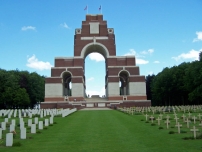| First Name: | Frank Oscar | Last Name: | ALBOROUGH | |
|---|---|---|---|---|
| Date of Death: | 07/10/1916 | Lived/Born In: | Edmonton | |
| Rank: | Lance Corporal | Unit: | East Kent (Buffs)6 | |
| Memorial Site: | Thiepval Memorial, France | |||
Current Information:Age-22 3, Church Lane, Edmonton
The Battle of the Somme (July-November, 1916) By the beginning of October, 1916, the Battle of the Somme had been raging for three months. Thousands of men had already been killed or wounded or were simply missing, never to be seen again and and just a few square miles of the French countryside, all in the southern part of the battlefield, had been captured from the enemy. Mistakes had been made by the various commanders and would be continued to be made but there was no turning back as the British, Australians, South Africans, New Zealanders and Canadians carried on battering away at the German defences in the hope of a breakthrough, So it continued all the way through to November with nearly every battalion and division then in France being drawn into it at some stage. In the end the German trenches had been pushed back a few more miles along most of the line but the cost in lives had been staggering. By the end of the fighting in November, 1916, British Army casualties numbered over 400,000, killed, wounded and missing. The Battle of Transloy Ridge On 1st October, 1916, a new offensive was begun by the British Army. The Battle of Transloy Ridge was the last major operation fought during the battle of the Somme and it continued throughout the first three weeks of the month until the terrible conditions of rain, mud and cold coupled with the sheer exhaustion of the troops, brought things to a standstill. The aim had been to push the enemy further back to the next ridge of higher ground running between Le Transloy and Warlencourt. It was a very hard fight, progress was painfully slow, the casualty figure was shockingly high and the final objective was not achieved despite the best efforts of the attacking divisions. Three factors worked against its success. The first was the weather. It was simply awful. The second was the miles of war torn terrain which soon became a quagmire over which troops, guns, ammunition and all the other supplies had to cross to reach the front and keep the momentum of the offensive going. For the Germans, falling back on their own supply lines across relatively unscathed ground, this was not such a problem. The third factor was the new methods of defence employed by the enemy. They defended in depth without a well defined front line but instead setting up machine-gun nests in shell holes and other strategically important sites where just a few men could hold up an entire battalion. And of course, the German artillery had the whole area covered. On 7th October, 1916, the British Army attacked on a wide front stretching from Lesboeufs, where the British line met the French, to Le Sars on the Albert to Bapaume road. It was not a great success. Very little ground was gained and the cost in casualties was extremely high. At zero hour, 1.45pm, 12th Division attacked with the village of Gueudecourt on their right flank. On the right of the divisional front 37 Brigade sent forward the 6th East Kent (Buffs) and the 6th Royal West Kent battalions but the Germans must have known that the attack was coming because an hour earlier 6th Buffs were heavily shelled and at 1.30pm tremendous machine-gun and shrapnel fire was opened up on the front trenches, still packed with men from the two battalions, causing many casualties before they got going. Nevertheless the attack proceeded and they went forward in four waves at fifty yards gaps with bayonets fixed and magazines charged. Each man carried 220 rounds and carrying parties followed behind bringing more. Their first objective was Hilt Trench, a continuation of Rainbow Trench, and Bayonet Trench but the machine-gun and rifle fire that was poured onto them as they advanced was so fierce that very few made it and there was very little chance of reaching the second objective. Despite bombing (grenade) attacks on them all afternoon from the high ground in front and enfilade fire from the flanks, the few survivors of 6th Buffs did manage to cling on to the few gains they had made until midnight when they were relieved, but only one officer and forty men then made it back out of the line. The battalion’s total casualties amounted to over 350, one of whom was Frank Alborough who was killed in action. |
||||
| « Back to Search Results | ||||
| If you think any of the information shown here is incorrect, Click Here to submit your amends and comments | ||||




